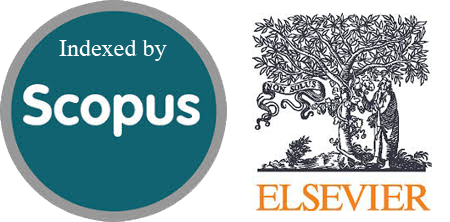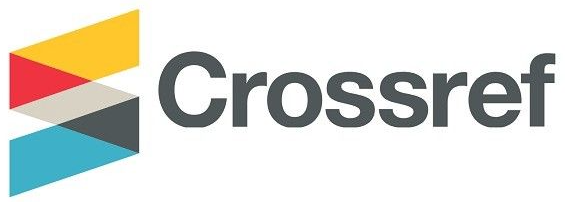Classification of Retinoblastoma Eye Disease on Digital Fundus Images Using Geometric Features and Machine Learning
Abstract
Medical image analysis is essential for detecting retinoblastoma tumors due to the ability of this method to assist doctors in examining the morphology, density, and distribution of blood vessels. The classification of normal and retinoblastoma-affected retinas is a preliminary step in treating retinoblastoma tumors. Therefore, this study aimed to propose a new method for classifying normal and retinoblastoma-affected retinas using geometric feature extraction and machine learning. The workflow consisted of (1) fundus image data collection for retinoblastomas, (2) image segmentation, (3) feature extraction process, (4) building a classification model using machine learning, (5) splitting testing and training data, (6) classification process using machine learning methods, and (7) evaluation of classification results using a confusion matrix. The results showed that the segmentation method could detect retinoblastoma areas and extract their geometric features. The SVM method achieved an accuracy of 0.96 while the RF and DT had 0.55 and 0.63, respectively. Moreover, a comparison with previous research showed that the proposed method achieved a 4% improvement in the classification performance. This led to the conclusion that classification using geometric features combined with the SVM on digital fundus images of retinoblastoma eye disease produced the best results.
Downloads
References
S. Wang, Y. Zhao, F. Yao, P. Wei, L. Ma, and S. Zhang, “An anti-GD2 aptamer-based bifunctional spherical nucleic acid nanoplatform for synergistic therapy targeting MDM2 for retinoblastoma,” Biomed. Pharmacother., vol. 174, no. March, p. 116437, 2024, doi: 10.1016/j.biopha.2024.116437.
K. Mcinnis-smith, T. Abruzzo, M. Riemann, L. F. Goncalves, and A. Ramasubramanian, “Utility of color Doppler imaging in patients with retinoblastoma treated by intra-arterial chemotherapy,” J. AAPOS, no. 3, p. 104093, doi: 10.1016/j.jaapos.2024.104093.
A. Ramasubramanian, M. Riemann, A. Brown, T. Abruzzo, and L. F. Goncalves, “Microvascular flow ultrasound imaging for retinoblastoma,” J. AAPOS, vol. 28, no. 1, p. 103801, 2024, doi: 10.1016/j.jaapos.2023.10.003.
G. M. S. AlQahtani, H. M. Alkatan, S. AlMesfer, S. Elkhamary, and A. M. Y. Maktabi, “A case of retinoblastoma masquerading as endophthalmitis: Unusual presentation and clinicopathological correlation,” Int. J. Surg. Case Rep., vol. 123, no. September, p. 110263, 2024, doi: 10.1016/j.ijscr.2024.110263.
Y. Liu, Y. Han, S. Chen, J. Liu, D. Wang, and Y. Huang, “Liposome-based multifunctional nanoplatform as effective therapeutics for the treatment of retinoblastoma,” Acta Pharm. Sin. B, vol. 12, no. 6, pp. 2731–2739, 2022, doi: 10.1016/j.apsb.2021.10.009.
J. Li, A. Li, Y. Liu, L. Yang, and G. Gao, “An adaptive fundus retinal vessel segmentation model capable of adapting to the complex structure of blood vessels,” Biomed. Signal Process. Control, vol. 101, no. April 2024, 2025, doi: 10.1016/j.bspc.2024.107150.
Y. Xu et al., “Deep learning for predicting circular retinal nerve fiber layer thickness from fundus photographs and diagnosing glaucoma,” Heliyon, vol. 10, no. 13, p. e33813, 2024, doi: 10.1016/j.heliyon.2024.e33813.
U. A. Nuli, S. D. Desai, and G. N. S. on L. D. P.-S. S. of R. F. I. Bhadri, “Study on Limited Data Problem - Semantic Segmentation of Retinal Fundus Images,” Procedia Comput. Sci., vol. 233, pp. 782–792, 2024, doi: 10.1016/j.procs.2024.03.267.
W. Xiao and Y. Lyu, “Human computer interaction product for infrared thermographic fundus retinal vessels image segmentation using U-Net,” J. Radiat. Res. Appl. Sci., vol. 17, no. 3, p. 101003, 2024, doi: 10.1016/j.jrras.2024.101003.
W. Huang and F. Liu, “HiDiffSeg: A hierarchical diffusion model for blood vessel segmentation in retinal fundus images,” Expert Syst. Appl., vol. 253, no. April, p. 124249, 2024, doi: 10.1016/j.eswa.2024.124249.
T. Fang, Z. Cai, and Y. Fan, “Gabor-net with multi-scale hierarchical fusion of features for fundus retinal blood vessel segmentation,” Biocybern. Biomed. Eng., vol. 44, no. 2, pp. 402–413, 2024, doi: 10.1016/j.bbe.2024.05.004.
S. Huang et al., “Automated interpretation of retinal vein occlusion based on fundus fluorescein angiography images using deep learning: A retrospective, multi-center study,” Heliyon, vol. 10, no. 13, p. e33108, 2024, doi: 10.1016/j.heliyon.2024.e33108.
X. Xia et al., “Benchmarking deep models on retinal fundus disease diagnosis and a large-scale dataset,” Signal Process. Image Commun., vol. 127, no. April, p. 117151, 2024, doi: 10.1016/j.image.2024.117151.
C. Y. T. Wong, T. Liu, T. L. Wong, J. M. K. Tong, H. H. W. Lau, and P. A. Keane, “Development and validation of an automated machine learning model for the multi-class classification of diabetic retinopathy, central retinal vein occlusion and branch retinal vein occlusion based on color fundus photographs,” JFO Open Ophthalmol., vol. 7, p. 100117, 2024, doi: 10.1016/j.jfop.2024.100117.
J. Liu et al., “Spectral reconstruction of fundus images using retinex-based semantic spectral separation transformer, applied for retinal oximetry,” Biomed. Signal Process. Control, vol. 94, no. April, p. 106301, 2024, doi: 10.1016/j.bspc.2024.106301.
S. Balasubramaniam, S. Kadry, and K. Satheesh Kumar, “Osprey Gannet optimization enabled CNN based Transfer learning for optic disc detection and cardiovascular risk prediction using retinal fundus images,” Biomed. Signal Process. Control, vol. 93, no. February, p. 106177, 2024, doi: 10.1016/j.bspc.2024.106177.
H. J. He, C. Zheng, and D. W. Sun, “Image Segmentation Techniques,” Comput. Vis. Technol. Food Qual. Eval. Second Ed., no. December, pp. 45–63, 2016, doi: 10.1016/B978-0-12-802232-0.00002-5.
Z. Liu, X. Jia, and X. Xu, “Study of shrimp recognition methods using smart networks,” Comput. Electron. Agric., vol. 165, 2019, doi: 10.1016/j.compag.2019.104926.
D. Li, L. Xu, and H. Liu, “Detection of uneaten fish food pellets in underwater images for aquaculture,” Aquac. Eng., vol. 78, no. December 2016, pp. 85–94, 2017, doi: 10.1016/j.aquaeng.2017.05.001.
Y. Han, T. Song, J. Feng, and Y. Xie, “Grayscale-inversion and rotation invariant image description with sorted LBP features,” Signal Process. Image Commun., vol. 99, no. June, p. 116491, 2021, doi: 10.1016/j.image.2021.116491.
S. N and V. S, “Image Segmentation By Using Thresholding Techniques For Medical Images,” Comput. Sci. Eng. An Int. J., vol. 6, no. 1, pp. 1–13, 2016, doi: 10.5121/cseij.2016.6101.
S. Du, K. Luo, Y. Zhi, H. Situ, and J. Zhang, “Jou lP,” Results Phys., p. 105710, 2022, doi: 10.1016/j.rinp.2022.105710.
J. Wang, J. Kosinka, and A. Telea, “Spline-based medial axis transform representation of binary images,” Comput. Graph., vol. 98, pp. 165–176, 2021, doi: 10.1016/j.cag.2021.05.012.
N. Halder, D. Roy, P. Roy, and P. Roy, “Qualitative Comparison of OTSU Thresholding with Morphology Based Thresholding for Vessels Segmentation of Retinal Fundus Images of Human Eye,” vol. 6, no. 3, pp. 41–48, 2016, doi: 10.9790/4200-0603024148.
X. Hu and Y. Wang, “Catena Monitoring coastline variations in the Pearl River Estuary from 1978 to 2018 by integrating Canny edge detection and Otsu methods using long time series Landsat dataset,” Catena, vol. 209, no. P2, p. 105840, 2022, doi: 10.1016/j.catena.2021.105840.
R. M. Ambrosi and J. I. W. Watterson, “The effect of the imaging geometry and the impact of neutron scatter on the detection of small features in accelerator-based fast neutron radiography,” Nucl. Instruments Methods Phys. Res. Sect. A Accel. Spectrometers, Detect. Assoc. Equip., vol. 524, no. 1–3, pp. 340–354, 2004, doi: 10.1016/j.nima.2003.12.042.
A. K. Jain, Fundamentals of Digital Image Processing. Pearson, 1988.
Z. Wu et al., “Effect of nozzle geometry features on the nozzle internal flow and cavitation characteristics based on X-ray dynamic imaging,” Nucl. Instruments Methods Phys. Res. Sect. A Accel. Spectrometers, Detect. Assoc. Equip., vol. 1058, no. October 2023, 2024, doi: 10.1016/j.nima.2023.168831.
D. Zeng, T. Zhang, R. Fang, W. Shen, and Q. Tian, “Neighborhood geometry based feature matching for geostationary satellite remote sensing image,” Neurocomputing, vol. 236, no. March 2016, pp. 65–72, 2017, doi: 10.1016/j.neucom.2016.08.105.
H. Zou, F. Da, and Z. Wang, “A novel 3D face feature based on geometry image vertical shape information,” Optik (Stuttg)., vol. 126, no. 9–10, pp. 898–902, 2015, doi: 10.1016/j.ijleo.2015.02.083.
M. Bourdeau et al., “Classification of daily electric load profiles of non-residential buildings,” Energy Build., vol. 233, p. 110670, 2021, doi: 10.1016/j.enbuild.2020.110670.
P. K. Gandla, V. Inturi, S. Kurra, and S. Radhika, “Evaluation of surface roughness in incremental forming using image processing based methods,” Meas. J. Int. Meas. Confed., vol. 164, p. 108055, 2020, doi: 10.1016/j.measurement.2020.108055.
J. P. M. Andries, M. Goodarzi, and Y. Vander Heyden, “Improvement of quantitative structure–retention relationship models for chromatographic retention prediction of peptides applying individual local partial least squares models,” Talanta, vol. 219, no. June, p. 121266, 2020, doi: 10.1016/j.talanta.2020.121266.
P. Barrett, “Euclidean Distance Whitepaper,” Tech. Whitepaper Ser. 6, p. 26, 2005.
S. Zhao et al., “Application of machine learning in intelligent fish aquaculture: A review,” Aquaculture, vol. 540, no. April, p. 736724, 2021, doi: 10.1016/j.aquaculture.2021.736724.
K. Madi, E. Paquet, and H. Kheddouci, “New graph distance for deformable 3D objects recognition based on triangle-stars decomposition,” Pattern Recognit., vol. 90, pp. 297–307, 2019, doi: 10.1016/j.patcog.2019.01.040.
K. Swathi and S. Kodukula, “Revue d ’ Intelligence Artificielle XGBoost Classifier with Hyperband Optimization for Cancer Prediction Based on Geneselection by Using Machine Learning Techniques,” vol. 36, no. 5, pp. 665–670, 2022.
K. Islam, S. Ali, S. Miah, and M. Rahman, “Machine Learning with Applications Brain tumor detection in MR image using superpixels , principal component analysis and template based K-means clustering algorithm,” Mach. Learn. with Appl., vol. 5, no. May, p. 100044, 2021, doi: 10.1016/j.mlwa.2021.100044.
D. Mou, Z. Wang, X. Tan, and S. Shi, “A variational inequality approach with SVM optimization algorithm for identifying mineral lithology,” J. Appl. Geophys., vol. 204, no. December 2021, p. 104747, 2022, doi: 10.1016/j.jappgeo.2022.104747.
M. Mustaqeem, “Principal component based support vector machine ( PC-SVM ): a hybrid technique for software defect detection,” Cluster Comput., vol. 24, no. 3, pp. 2581–2595, 2021, doi: 10.1007/s10586-021-03282-8.
Y. Wang et al., “Abnormal intrinsic brain functional network dynamics in patients with retinal detachment based on graph theory and machine learning,” Heliyon, vol. 10, no. 23, 2024, doi: 10.1016/j.heliyon.2024.e37890.
M. Saberioon and P. Císař, “Automated within tank fish mass estimation using infrared reflection system,” Comput. Electron. Agric., vol. 150, no. May, pp. 484–492, 2018, doi: 10.1016/j.compag.2018.05.025.
V. C. F. Aiken, J. R. R. Dórea, J. S. Acedo, F. G. de Sousa, F. G. Dias, and G. J. de M. Rosa, “Record linkage for farm-level data analytics: Comparison of deterministic, stochastic and machine learning methods,” Comput. Electron. Agric., vol. 163, no. March, p. 104857, 2019, doi: 10.1016/j.compag.2019.104857.
W. Gao and Z. H. Zhou, “Towards convergence rate analysis of random forests for classification,” Adv. Neural Inf. Process. Syst., vol. 2020-Decem, p. 103788, 2020, doi: 10.1016/j.artint.2022.103788.
G. Yoshikazu, P. Krecl, and A. Créso, “Science of the Total Environment Fine-scale modeling of the urban heat island : A comparison of multiple linear regression and random forest approaches,” vol. 815, 2022, doi: 10.1016/j.scitotenv.2021.152836.
A. Zermane, M. Z. Mohd Tohir, H. Zermane, M. R. Baharudin, and H. Mohamed Yusoff, “Predicting fatal fall from heights accidents using random forest classification machine learning model,” Saf. Sci., vol. 159, no. November 2022, p. 106023, 2023, doi: 10.1016/j.ssci.2022.106023.
M. Ghane, M. C. Ang, M. Nilashi, and S. Sorooshian, “Enhanced decision tree induction using evolutionary techniques for Parkinson’s disease classification,” Biocybern. Biomed. Eng., vol. 42, no. 3, pp. 902–920, 2022, doi: 10.1016/j.bbe.2022.07.002.
L. Spirkovska, “Three-dimensional object recognition using similar triangles and decision trees,” Pattern Recognit., vol. 26, no. 5, pp. 727–732, 1993, doi: 10.1016/0031-3203(93)90125-G.
S. K. Singla, R. D. Garg, and O. P. Dubey, “Ensemble machine learning methods to estimate the sugarcane yield based on remote sensing information,” Rev. d’Intelligence Artif., vol. 34, no. 6, pp. 731–743, 2020, doi: 10.18280/RIA.340607.
A. K. Al-Musawi, F. Anayi, and M. Packianather, “Three-phase induction motor fault detection based on thermal image segmentation,” Infrared Phys. Technol., vol. 104, no. November 2019, p. 103140, 2020, doi: 10.1016/j.infrared.2019.103140.
G. M. H. Amer and A. M. Abushaala, “Edge detection methods,” 2015 2nd World Symp. Web Appl. Networking, WSWAN 2015, no. August 2015, pp. 1–8, 2015, doi: 10.1109/WSWAN.2015.7210349.
C. E. Widodo and K. Adi, “Face geometry as a biometric-based identification system,” J. Phys. Conf. Ser., vol. 1524, no. 1, 2020, doi: 10.1088/1742-6596/1524/1/012008.
Y. Yang, X. Zhao, M. Huang, X. Wang, and Q. Zhu, “Multispectral image based germination detection of potato by using supervised multiple threshold segmentation model and Canny edge detector,” Comput. Electron. Agric., vol. 182, no. September 2020, p. 106041, 2021, doi: 10.1016/j.compag.2021.106041.
Copyright (c) 2025 Jurnal RESTI (Rekayasa Sistem dan Teknologi Informasi)

This work is licensed under a Creative Commons Attribution 4.0 International License.
Copyright in each article belongs to the author
- The author acknowledges that the RESTI Journal (System Engineering and Information Technology) is the first publisher to publish with a license Creative Commons Attribution 4.0 International License.
- Authors can enter writing separately, arrange the non-exclusive distribution of manuscripts that have been published in this journal into other versions (eg sent to the author's institutional repository, publication in a book, etc.), by acknowledging that the manuscript has been published for the first time in the RESTI (Rekayasa Sistem dan Teknologi Informasi) journal ;






